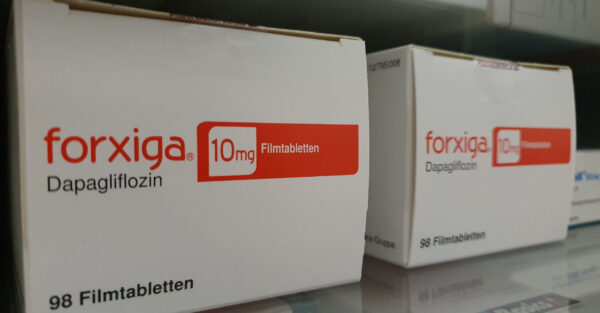|
Farxiga’s HF Extension | Statins’ Blood Vessel Benefits
May 11, 2023
|
|
|

|
|
Together with
|

|
|
|
“A reminder that Elsevier made $10.5 BILLION in 2022 from selling your academic journals and articles behind paywalls, and make more profit than Amazon, Google, and Apple every year…”
|
|
A viral tweet from Dr. Jessica Taylor that surpassed 2.8M views and 7,882 retweets as of yesterday evening.
|
|
|
Cardiology Pharmaceuticals
|
|
|
|

|
|
AstraZeneca’s Farxiga (dapagliflozin) oral SGLT2 inhibitor just landed FDA approval for a far wider range of heart failure patients, now covering risk reduction of cardiovascular death, heart failure hospitalization, and urgent heart failure ED visits among all adults with HF — regardless of their left ventricular ejection fraction status.
That’s a notable extension from Farxiga’s previous approval for patients with HFrEF, and should add even more HF momentum for SGLT2 inhibitors.
This is the latest in a series of Farxiga’s FDA extensions, which gained its initial approval for type 2 diabetes patients in 2014, and has since added FDA approvals for preventing HF in type 2 diabetes patients (2019), reducing the risk of CV death and hospitalization in HFrEF patients regardless of diabetes status (2020), and risk reduction in patients with CKD (2021).
Farxiga’s FDA extension stands on the shoulders of two key 2022 studies.
- The phase III DELIVER Trial showed that Farxiga significantly reduced CV death or worsening HF in patients with HFmrEF or HFpEF.
- Pooled analysis of the DAPA-HF and DELIVER Phase III trials showed that Farxiga reduced composite risks (CV death, HF hospitalization, urgent heart failure) in patients across the LVEF range.
Those results (which include many HF “firsts” for SGLT2s) and Farxiga’s newly-expanded HF approvals could position AstraZeneca as a HF treatment leader, although Farxiga has some catching up to do with Eli Lilly and Boehringer Ingelheim’s Jardiance (empagliflozin), which gained similar “all HF” approval in early 2022.
In reality, both SGLT2s are likely on track for huge years, noting that Farxiga’s previous indications drove $4.3B in 2022 revenue (+46% YoY), while and Boehringer Ingelheim’s Jardiance 2022 revenue soared to $6.35B (+48% YoY) following its own HF extensions.
The Takeaway
America’s 7 million heart failure patients have historically had to live with the fact that nearly half of them would die within five years of diagnosis, but the recent surge of SGLT2 inhibitor treatments and approvals seems to be changing the HF paradigm. That shift is big news for AstraZeneca and its peers in the “all HF patients” SGLT2 club, and should drive big changes in how we detect and care for HF patients – especially if payors’ SGLT2 coverage also changes.
|




|
|
AI to Democratize Echo
Us2.ai published what might be the most comprehensive paper we’ve seen on AI echo, detailing the benefits of AI-automated echocardiography, the global need for more scalable and flexible CVD assessments, and how its technology is fit for the future. If you’re focused on the echo, echo AI, or echo accessibility and efficiency, this paper is worth checking out.
|
|
The First Step to Coronary Artery Disease Diagnosis
HeartFlow’s new RoadMap Analysis solution allows CT readers to accurately, efficiently, and consistently identify stenoses in the coronary arteries. See how RoadMap Analysis’ visual and quantitative insights into the narrowing of all major coronary arteries helps readers evaluate coronary CT angiograms before determining the need for an FFRCT.
|
|
Reducing ECG Background Noise
Monebo’s Kinitec Rhythms ECG Algorithm separates true ECG signals from background noise, leading to more accurate diagnoses and improved operator efficiency. See for yourself how the algorithm measured up to a gold standard.
|
|
- Beta Blockers Challenges: Two new studies highlighted the challenges (and potential harms) of prescribing beta blockers to patients with less severe CV issues. A BMJ Heart study of 34k patients who experienced heart attacks and didn’t have HF or LV systolic dysfunction found that patients who were and weren’t taking beta blockers had comparable outcomes after a median of 4.5 years. Another JACC: Heart Failure study analyzed data from 436k patients with HF and EF ≥40% (mildly reduced & normal EF), finding that patients on beta blockers had far greater risk of HF hospitalization and death.
- Magenta Medical’s $55M: Israeli heart pump startup Magenta Medical wrapped up a $55M financing round to advance clinical programs supporting its percutaneous Left Ventricular Assist Device (pLVAD) as it seeks FDA approval. Magenta’s pLVAD is inserted via percutaneous groin access, and expanded for activation inside the left ventricle where the pump can be adjusted according to each patient’s clinical circumstances. The company suggests the pLVAD could treat a range of MCS patients with a single device, potentially eliminating the need for multiple invasive replacement procedures.
- EV Chargers’ CIED Safety: A new study out of Germany suggests that patients with pacemakers and implantable defibrillators can safely charge their electric vehicles at high-powered charging stations. The researcher had 130 people with CIEDs perform 561 charges while being monitored with ECGs, finding no incidences of electromagnetic interference. However, the authors still encouraged CIED patients to minimize their time around charging stations due to their higher effective magnetic fields.
- Explaining Statins’ Blood Vessel Benefits: Statins’ are known to deliver blood vessel benefits unrelated to cholesterol reduction, and Stanford Medicine researchers just figured out why. Using genetic tools and lab-grown endothelial cells (which make up the lining of blood vessels), the researchers found that statins prevent the “YAP” protein from entering the cell nucleus and opening chromatin structures, which are associated with endothelial-to-mesenchymal cell transitions (common with vascular diseases). They also found that endothelial cells treated with statins formed more capillary-like tubes, while eight weeks of statin therapy significantly improved diabetic mice’s vascular function.
- Unpaid Peer Review: The rebellion against for-profit academic publishing is gaining steam. A new survey in Research Integrity and Peer Review found that editors who perform unpaid peer reviews for academic journals contribute work that would be valued at $6B annually worldwide – or $1,272 per person – if they were compensated. The report comes a month after editors of a neuroimaging journal quit en masse following Elsevier’s refusal to lower publishing fees, and just before a viral Twitter thread about how Elsevier profits from “free” labor.
- Lp(a) & OxPLs in CAD: The CASABLANCA study showed that Lp(a) and two oxidized phospholipids (OxPLs) are associated with multivessel CAD and MACE incidence. Among over 1k participants, Lp(a), OxPL-apoB, and OxPL-apo(a) were strongly correlated. Interestingly, OxPL-apoB showed a slightly stronger association with CAD and MACE compared with Lp(a), suggesting it could be a target for lowering residual risk in patients treated with Lp(a)-reducing therapies. The risk for MACE per doubling of Lp(a), OxPL-apoB, and OxPL-apo(a) were 8%, 15%, and 7% respectively.
- Avertix/Angel SPAC Deal: Avertix (previously known as Angel Medical Systems) announced plans to go public through a SPAC merger with BIOS Acquisition Corporation during H2 2023, in a deal that values Avertix at $195M and would leave the company with $239M in cash to drive its commercial growth. Avertix’s FDA-approved Guardian System is implanted in patients with Acute Coronary Syndrome to detect heart attacks in real-time and alert patients and providers to seek medical care.
- Gut Microbiome Linked to Atrial Fibrillation: A large population-based study (n=6,763) from the FINRISK 2002 cohort found associations between gut microbiota and AF. The researchers discovered nine microbial genera linked to prevalent AF and eight genera linked to incident AF over a 15-year follow-up. Both prevalent and incident AF were significantly associated with Enorma and Bifidobacterium genera. The results establish a foundation for using microbiome profiles in AF risk prediction, and could pave the way for gut-based prevention and targeted treatments.
- Siemens Cuts Corindus’ Cardiology: Less than four years after Siemens Healthineers acquired Corindus for $1.1B with plans to create a robotics-assisted endovascular cardiology treatment platform, Siemens canceled Corindus’ cardiology-related business to refocus on neurovascular applications. Siemens explained that the Corindus robots for cardiology “did not fulfill (their) expectations.” Its decision to turn the Corindus CorPath robotics business “into an R&D project” will come with a $362M writedown, while the forthcoming neuro system will take several years before it’s ready for market.
- Night-Time BP Risk Prediction: A large cohort study out of Spain (59.7k people, 9.7yr median follow-up) suggests that night-time systolic blood pressure, obtained through 24-hour ambulatory BP monitoring, is a far stronger predictor of all-cause mortality and cardiovascular death than conventional clinic systolic blood pressure. Among 7,174 patients who died (2,361 from cardiovascular causes), night-time systolic BP was roughly six-times more informative about patients’ risk of all-cause or cardiovascular death than clinic systolic BP, while 24-hour ambulatory BP was five-times more informative.
- TTG Buys SPECT Pioneer Digirad: Digital gamma camera pioneer Digirad Health has been acquired by TTG Imaging Solutions, a molecular imaging equipment and radiopharmaceuticals company that’s expanded across the U.S. in recent years. Digirad was one of the first companies to sell a solid-state digital SPECT camera and has historically focused on cardiac imaging. The acquisition will expand TTG’s presence in the cardiac SPECT arena and across the Western U.S.
|
|
The Benefits of Outsourced Post-Processing
Using an outsourced cardiac image post-processing solution doesn’t have to mean sacrificing control of the results. Discover how PIA’s customizable post-processing workflow can help you get the most out of your images.
|
|
The Behavioral Science Behind Change Cardiology Hemo
When Change Healthcare set out to design its next-generation Cardiology Hemo monitoring system, they put behavior science at the heart of its product strategy. See how Change’s UX designers applied its behavioral science team’s findings to improve its Hemodynamics solution to help make physicians and technicians even more efficient.
|
|
How Precision Heart Therapy Advances the Business of Healthcare
Health systems continue to face economic and regulatory pressure to reduce care costs and improve outcomes. See how Cleerly’s precision heart care approach helps enhance patient care, avoid unnecessary and high-cost procedures, and improve the patient and provider experience.
|
|
|
|
|